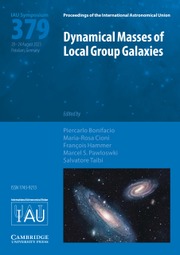No CrossRef data available.
Article contents
A Statistical Method for Detecting Gravitational Recoils of Supermassive Black Holes in Active Galactic Nuclei
Published online by Cambridge University Press: 23 June 2017
Abstract
We propose an observational test for gravitationally recoiling supermassive black holes in active galactic nuclei, based on a positive correlation between the velocities of black holes relative to their host galaxies, |Δv|, and their obscuring dust column densities, Σdust, both measured along the line of sight. Our findings using a set of toy models implemented to a Monte Carlo simulation imply that models of the galactic centre and of recoil dynamics can be tested by future observations of the potential Σdust–|Δv| correlation. We have also found that the fraction of obscured quasars decreases with |Δv|, for which the predicted trend can be compared to the observed fraction of type II quasars, and can further test combinations of models we may implement.
Information
- Type
- Contributed Papers
- Information
- Proceedings of the International Astronomical Union , Volume 12 , Symposium S324: New Frontiers in Black Hole Astrophysics , September 2016 , pp. 227 - 230
- Copyright
- Copyright © International Astronomical Union 2017

